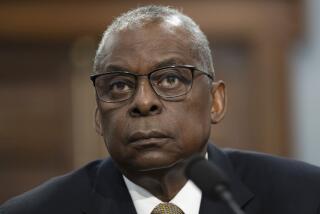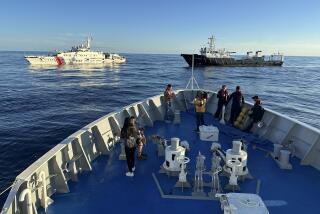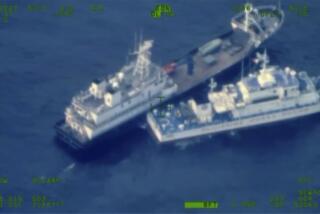Rebels Shoot at U.S. Troops in Philippines
- Share via
WASHINGTON — U.S. troops came under fire from rebels in the Philippines on Monday for the first time since beginning a training exercise in February, the Pentagon said.
The U.S. Marines and Philippine soldiers returned fire, killing at least some of the guerrillas, and suffered no casualties themselves. The incident marked the first direct U.S. confrontation with the rebels plaguing the Philippines.
The clash came as President Bush neared a decision on a recommendation by top military officers to intensify operations in the Southeast Asian nation.
At issue is the U.S. role in a combat zone in the southern Philippines, where Abu Sayyaf guerrillas who have been linked to the Al Qaeda terrorism network are trying to carve out a Muslim nation. Senior American defense officials were to meet with Bush this week to discuss the issue.
Defense Secretary Donald H. Rumsfeld on Monday declined to detail his recommendation to Bush, but a broad array of military officials have called for a longer and more intense mission. A senior defense official, speaking on condition of anonymity, said the officers include U.S. commanders in the Philippines; the regional commander in the Pacific, Adm. Thomas Fargo; and Air Force Gen. Richard B. Myers, chairman of the Joint Chiefs of Staff.
In a Pentagon briefing, Rumsfeld said the decision has “jelled” and would probably be “sorted out in the next few days” both within the Bush administration and the Philippine government.
The Americans joined in the firefight after gunmen shot at a group that included two Marines and a number of Philippine soldiers who were guarding U.S. Navy Seabees working on roads and bridges on impoverished Basilan island, said Navy Lt. Cmdr. Jeff Davis, a Pentagon spokesman.
Davis said at least some of the fighters who fired on the party were killed at a work site 10 miles southeast of the town of Isabela.
Fargo and his commanders in the Philippines have urged the Bush administration to transform the training exercise into a combat mission, allowing U.S. advisors to join directly in the search for Abu Sayyaf rebels and to stay beyond July, when the exercise is due to end.
Deputy Defense Secretary Paul D. Wolfowitz visited American forces in the Philippines last month and has since filed a report. His recommendation is not known.
Under the proposal favored by commanders, the July deadline would be extended and U.S. Army Special Forces soldiers, or Green Berets, who now can train only brigade-sized groups of hundreds of soldiers, would be allowed to instruct companies of fewer than 100 troops and join them on patrols, the senior defense official said.
U.S. interest in the guerrilla war was heightened May 27, 2001, when Abu Sayyaf rebels kidnapped American missionaries Martin and Gracia Burnham. In the wake of Sept. 11, after reports that some of the rebels had joined Al Qaeda fighters in Afghanistan, the Philippines became the first non-Afghan focus of U.S. troops in a global war on terrorism.
But the rules of engagement for the exercise prohibit U.S. forces from joining directly in the fight against the rebels, limiting them to training efforts. U.S. commanders in the Philippines said they helped craft but took no direct part in the June 7 mission in which Martin Burnham and Philippine hostage Deborah Yap were killed and Gracia Burnham was rescued.
Heightened U.S. involvement would probably intensify domestic opposition to Philippine President Gloria Macapagal Arroyo in a nation where the constitution forbids combat operations by foreign military personnel except in a state of emergency.
Many American officials contend that keeping U.S. forces in Southeast Asia is key to reducing a breeding ground for potential Muslim terrorists.
There are more than 1,000 American troops in the Philippines. They include Green Berets training Filipinos on Basilan island, and Marines and Navy Seabees.
Meanwhile, Rumsfeld said Monday that the destruction of Al Qaeda’s safe haven in Afghanistan has led the group to focus on new operations and to join with like-minded organizations in other countries. Some officials cite a bombing last week that killed 12 Pakistanis outside the U.S. Consulate in Karachi as a possible example, although it remains unclear who caused the explosion.
“We keep doing things that disrupt their ability to engage in terrorist acts, but unquestionably, we’re not going to disrupt them all,” Rumsfeld said. “There’s no way to do that. Life’s not perfect.”
In Afghanistan, Myers said, a stash of 30 surface-to-air missiles recovered in recent days by U.S. soldiers near the Pakistani border included HN-5 models made in China. American- and Russian-made missiles also were known to be widely available in Afghanistan.
The stash was among as many as 10 separate caches of weapons, including hundreds of rockets, mortar launchers and other equipment, discovered over the past two weeks.
Rumsfeld also said Pakistan has shifted more troops to its border with Afghanistan, site of repeated incursions by Al Qaeda operatives, as tensions have eased with India.
More to Read
Sign up for Essential California
The most important California stories and recommendations in your inbox every morning.
You may occasionally receive promotional content from the Los Angeles Times.













